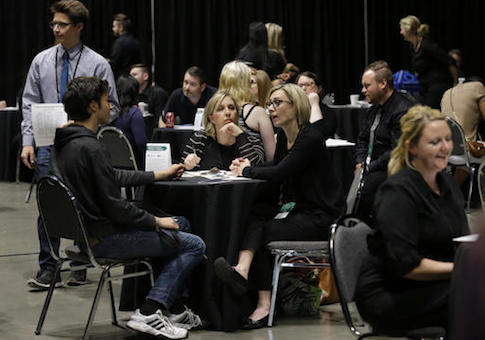There were 94,333,000 Americans not participating in the labor force in July, a decline of 184,000 people from the previous month, according to data released by the Bureau of Labor Statistics on Friday.
The bureau counts those not in the labor force as people who do not have a job and did not actively seek one in the past four weeks.
The labor force participation rate, which is the percentage of the population that has a job or actively looked for one in the past month, increased from 62.7 percent in June to 62.8 percent in July.
There were 56,620,000 women not in the labor force in July, a decline of 235,000 from the previous month. Their participation rate increased from 56.6 percent in June to 56.8 percent in July.
The unemployment rate for all Americans remained steady at 4.9 percent from June to July. This measure does not account for those individuals who have dropped out of the labor force and simply measures the percent of those who did not have a job but actively sought one over the month.
The "real" unemployment rate, otherwise known as the U-6 measure, was 9.7 percent, which increased from 9.6 percent from the previous month. Democrats such as Sen. Bernie Sanders (I., Vt.) and Federal Reserve chair Janet Yellen have said this measure accounts for discouraged workers and those working part time instead of full time for economic reasons and is more representative of the labor market.
There were 5,940,000 Americans working part-time in July, who would rather have a full-time job but cited economic reasons for not doing so. This number increased by 97,000 over the month.
According to the bureau, involuntary part-time workers are "persons who indicated that they would like to work full time but were working part time (1 to 34 hours) because of an economic reason, such as their hours were cut back or they were unable to find full-time jobs."
"There was little change in small business owner employment activity from June to July," said William C. Dunkelberg, chief economist at the National Federation of Independent Business. "This is consistent with the second quarter GDP growth of 1.2 percent. Policymakers need to keep in mind that without a robust small business sector, the economy will continue to grow at a sluggish pace."
"The explosion of new regulations is a ball and chain for small business," added National Federation of Independent Business president and CEO Juanita Duggan. "Federal agencies have been churning out new mandates at a dizzying pace, and that creates more risk and uncertainty for small business owners. The regulatory climate is suffocating small business investment and hiring."
"Today’s jobs number overlooks what I see on the ground every day in the human resources industry: The economy is much weaker than many policymakers and commentators claim," said Adam Robinson, CEO of Hireology and member of the Job Creators Network. "To finally get the economy growing for everyone again, we must focus on cutting the tax and regulatory barriers to economic and labor market growth."
